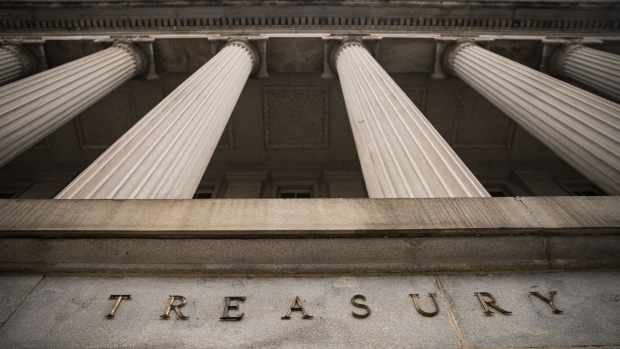Apr 18, 2024
Treasuries Jump With Dollar as Middle East Risks Fan Haven Bid
, Bloomberg News

(Bloomberg) -- Treasuries all but erased their biggest rally of the year as investor focus shifted back to the US inflation outlook following an escalation of Middle East conflict that stoked demand for havens.
The US 10-year yield rebounded to nearly 4.63%, within a basis point of Thursday’s closing level, after falling as much as 14 basis points to the lowest level in more than a week. Haven demand spurred by the Iran-Israel missile exchange began to ebb on indications that a broader conflict isn’t imminent. Flows included demand for options offering protection against the 10-year yield reaching 4.7% by May 24.
The market’s latest bout of volatility caps a week in which Treasury yields attained their highest levels of the year in response to persistently strong US economic data and indications from Federal Reserve officials that the three quarter-point interest-rate cuts they forecast in March have become less likely. On Friday, Chicago Fed President Austan Goolsbee became the latest to deliver that message, saying the inflation trend means “it makes sense to wait.”
“The inflation discussion is far more important for Treasuries than the geopolitical discussion at the moment,” said Peter Kinsella, the global head of FX strategy at Union Bancaire Privee. “Everything suggests there is limited appetite on either side to really increase confrontation. So it’s mainly about inflation and central banks.”
Market-implied expectations for Fed rate cuts have collapsed over the past two weeks, during which March data on US employment, inflation and retail sales exceeded economists estimates. Fed Chair Jerome Powell was among the several central bank officials to deliver the message in the past week that there’s no urgency to cut rates.
Swap contracts that predict Fed rate decisions no longer fully price in more than a single quarter-point cut this year, and not until November at the earliest. As recently last month, they priced in three quarter-point cuts beginning in June.
“Markets are confused on whether they should be going for safe havens or whether they should worry about higher US inflation and the Fed not cutting,” said Matt Cairns, head of credit strategy at Rabobank.
Interest-rate options activity this week has featured wagers on the Fed not cutting rates at all this year and possibly raising them further — a contingency that New York Fed President John Williams in remarks Thursday suggested couldn’t be ruled out.
A gauge of the dollar was little changed, having climbed as much as 0.6% to its highest since November earlier. European government bonds also pared their gains, while Brent crude erased its advance after briefly spiking past $90 per barrel.
At the same time, there have been indications — including a strong reception for this week’s auctions of 20-year Treasury bonds and 5-year inflation-protected Treasuries — that investors continue to be tempted by yield levels.
“I would say that we’ve seen a material rise in US yields over recent weeks, and a lot of investors and traders, including systematic accounts, will likely be running short US bond positions,” said Andrew Ticehurst, rates strategist for Nomura Holdings Inc. in Sydney. “So there is clear risk that some of these positions will be covered, which could lead to out-sized moves.”
--With assistance from Ruth Carson, Masaki Kondo, Tian Chen and Edward Bolingbroke.
(Adds Friday’s market activity and context, updates yields.)
©2024 Bloomberg L.P.






